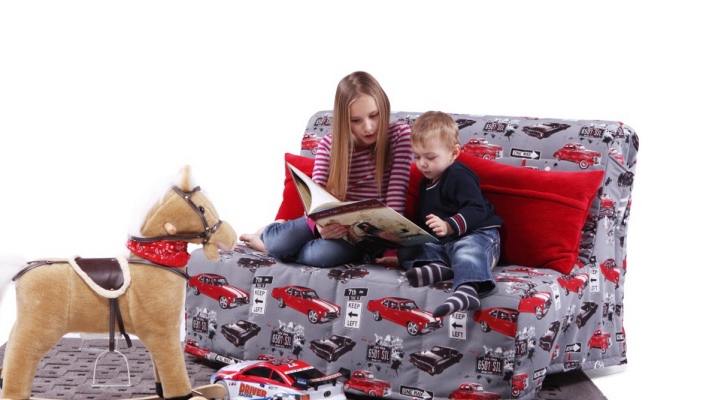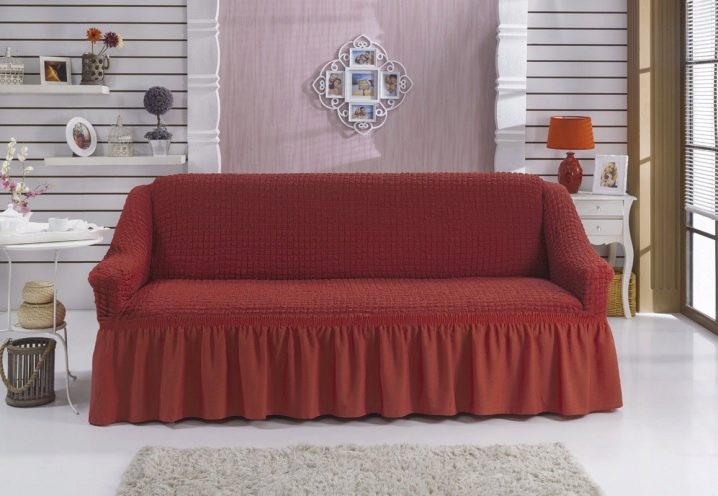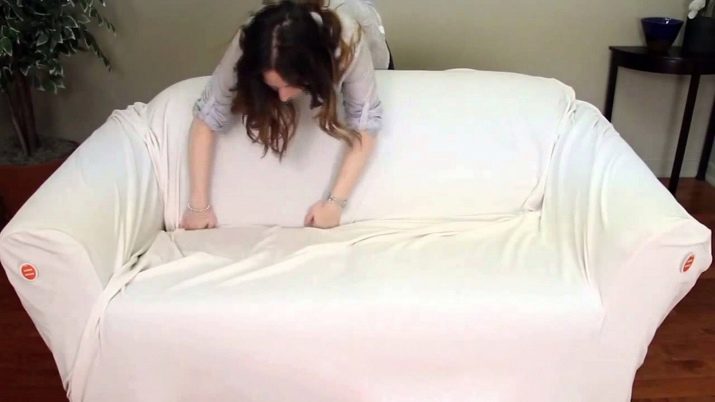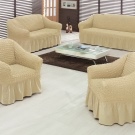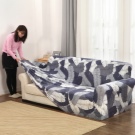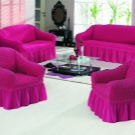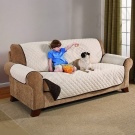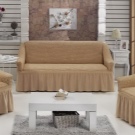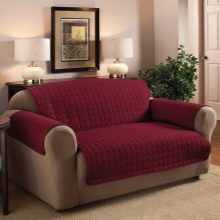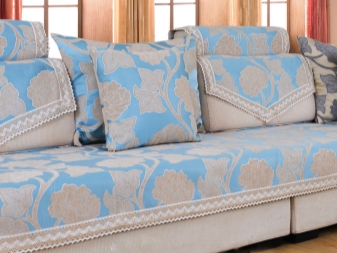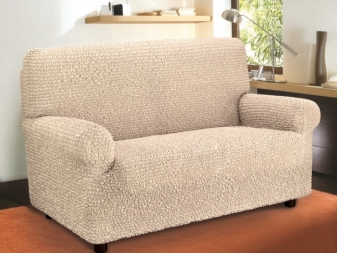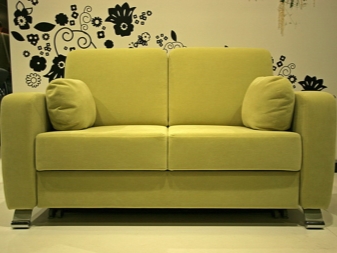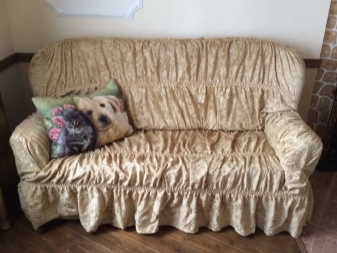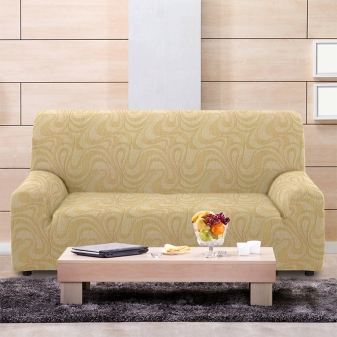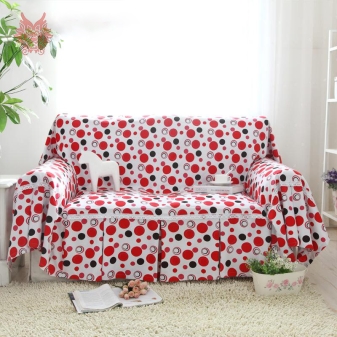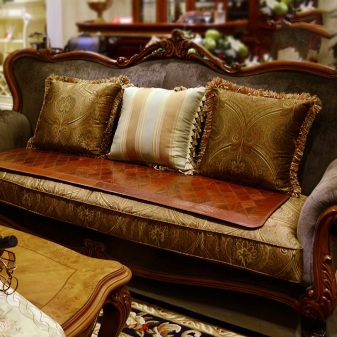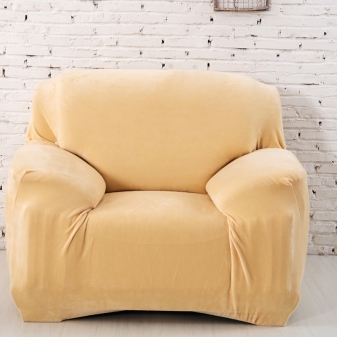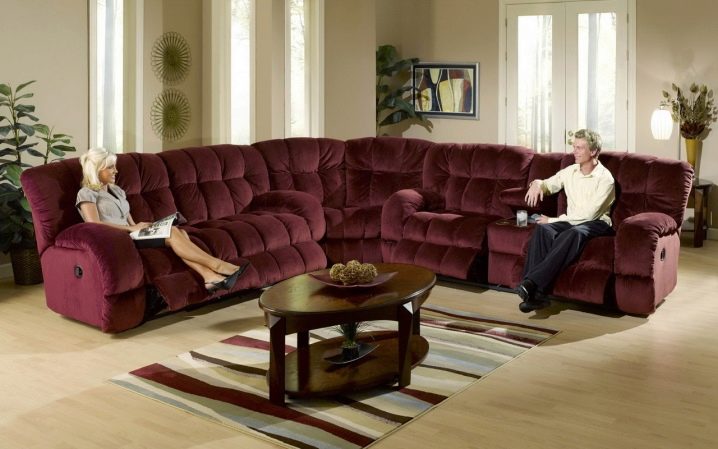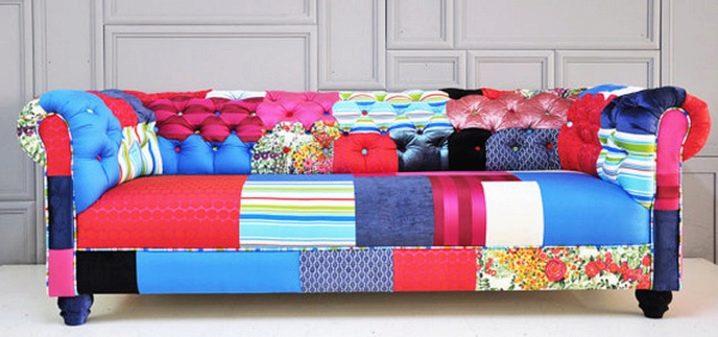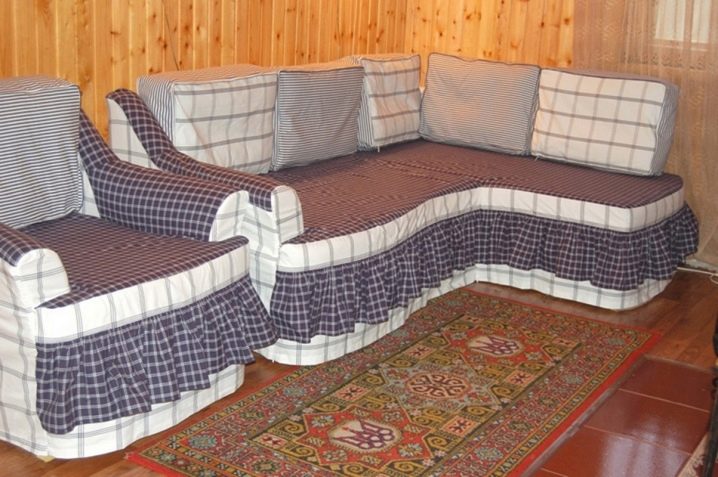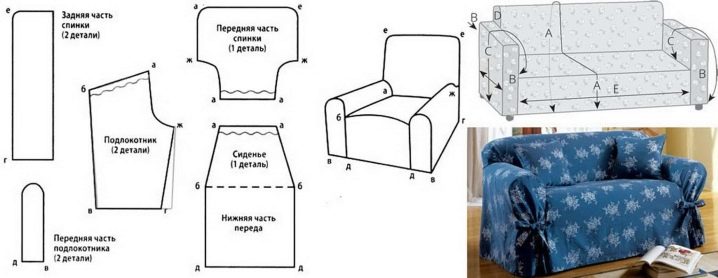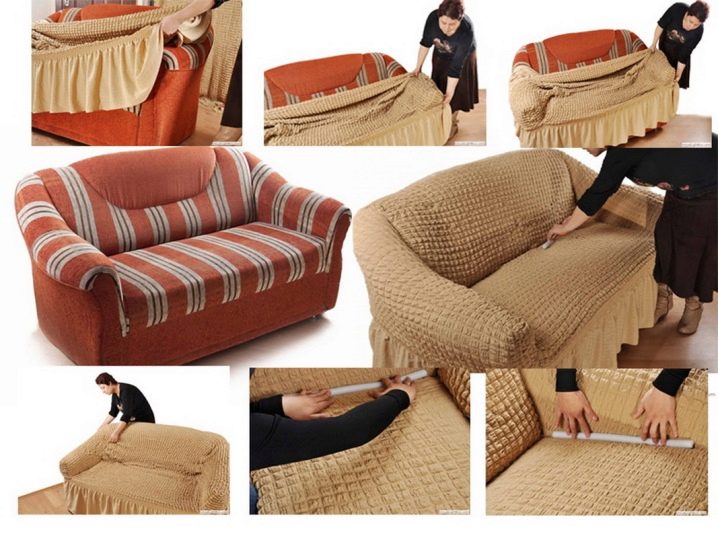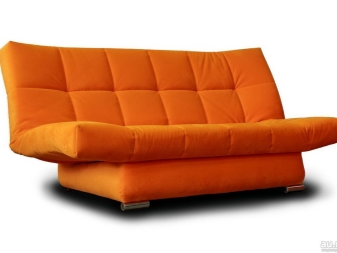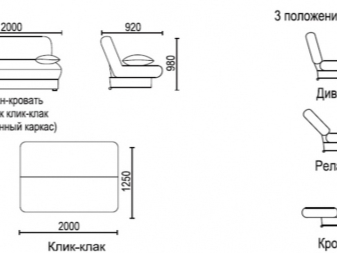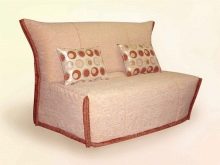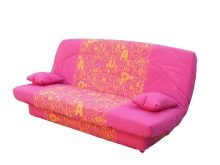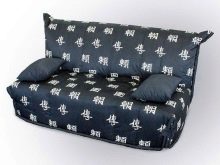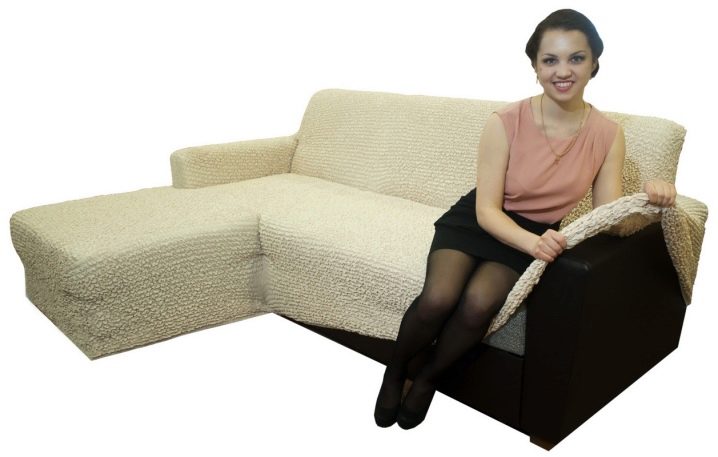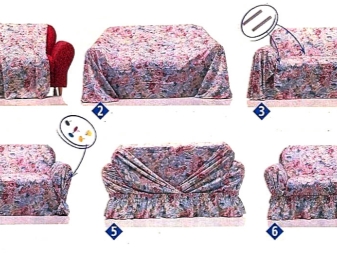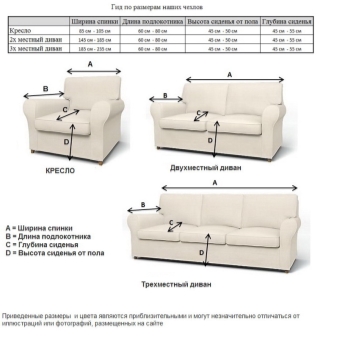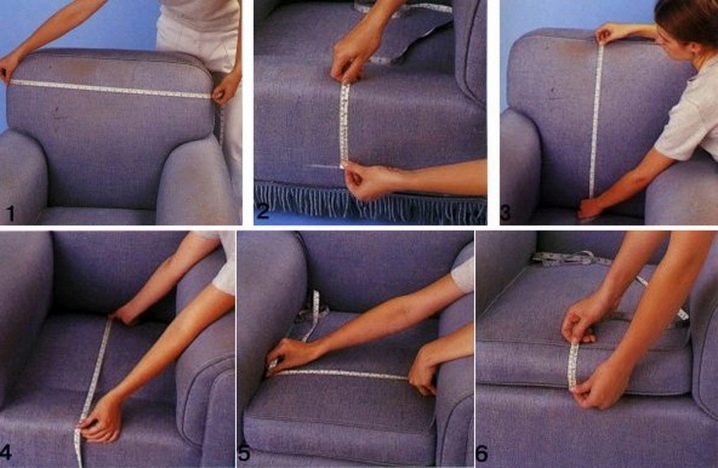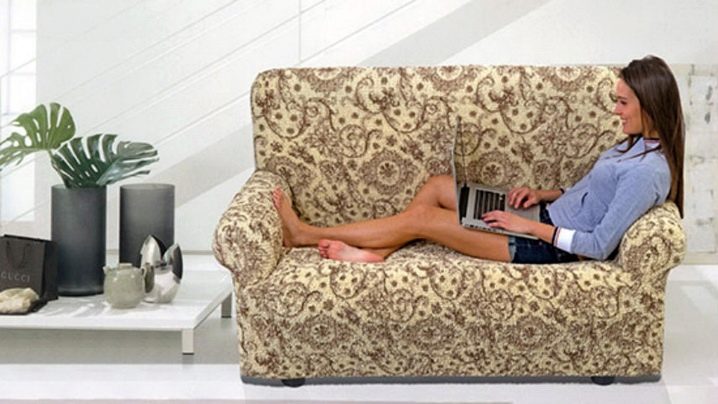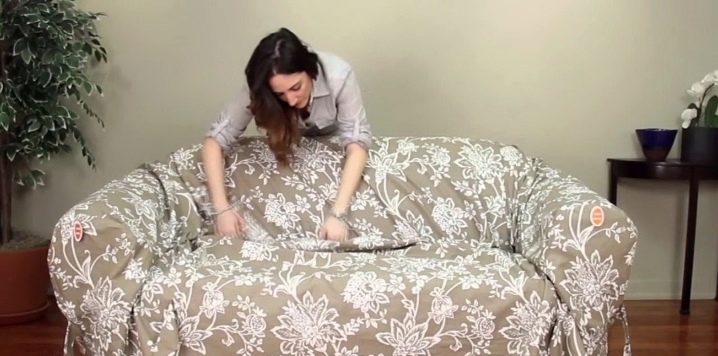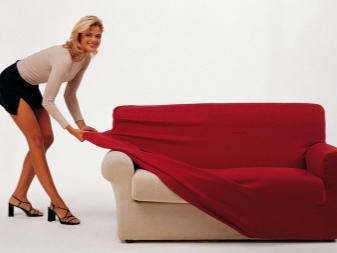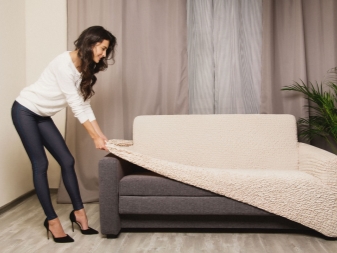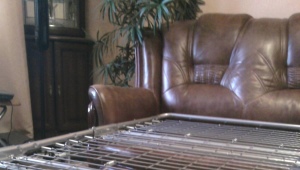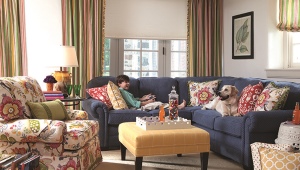Sofa cover
Upholstery on furniture, especially on sofas due to frequent use can quickly lose its attractive appearance. It becomes worn, in some places dims. To prevent such a situation can help ordinary cover on the sofa.
Special features
Sofa cover - a universal thing. It has a number of features and advantages, which confirm only the need for its use:
- Cover-cape helps to preserve the original appearance of the upholstery for a long time.
- Suitable for all sizes of sofas regardless of their size and shape.
- It has a huge version of various models: on an elastic band, a cover-cape, a tension cover, dimensionless and so on.
- It can be made of material of any texture and color.
- Covers allow you to change the design of the sofa in a few minutes. With their help, you can drastically change the overall perception of the interior space.
- Unlike a sofa upholstery, covers are much simpler and more convenient not only in operation, but also in care.
- Such capes can be used on sofas of any size and shape.including modular and transforming sofas. This results from the fact that even if on sale there is no cover necessary for you, it can easily be made houses independently.
- Another feature and at the same time the main advantage of sofa covers is their efficiency. Their use in everyday life helps save a lot. After all, such a furniture cover in any case will cost much less than the acquisition of a new sofa or its restoration.
Those who already use such capes on the sofa in everyday life say that they significantly save time, effort and money. To create them using a variety of materials.
Materials
For the manufacture of sofa covers can be used absolutely any existing materials today. However, experienced seamstresses say that it is necessary to avoid too dense upholstery fabrics that are used directly when creating sofas, since they are difficult to use and at home it will be difficult to create a beautiful and practical cover from them.It is also not recommended to use too light fabric, such as chiffon or satin. Of course, covers made of these materials look luxurious, only in the care they are not very practical, and wear out pretty quickly.
The following are considered the best fabric options for creating such a cover:
- Flock or artificial velvet substitute. It is very soft, pleasant to the touch. The great advantages of this material are its characteristics: it is easy to clean, does not undergo deformation, does not change the intensity of the color of paints, even with prolonged exposure to the sun. It is also important that this fabric has good water repellents due to its high density. Also, it is in the flock that laundry mites are the least likely to start. The material is very light and easy to use, but sometimes it can cause an allergic reaction.
- Cotton or wool velor. This fabric is not capable of causing allergies, is not a source of static current accumulation, has a long service life and is very easy to clean, does not deform after washing. The disadvantages of this material are a decent cost, as well as relatively high brittleness, for example, cat's claws can quickly make such a case unusable.
- Microfiber or artificial suede substitute. It is advisable to give preference to a fabric that has previously been soaked with a special Teflon mixture. It will not only be soft and pleasant to the touch and durable, but will repel water, grease and dirt from its surface. To the touch this fabric is very soft and pleasant. It does not fade in the sun and is not deformed, does not cause allergic manifestations.
- Teflon flock - universal fabric for a sofa cover in case there are animals or small children in the house. It has the same qualities as a normal flock, but in addition to them it also repels any type of pollution from its surface and does not absorb water at all. To soil such a cover is almost impossible.
- Jacquard - It is a fabric with increased strength. It is not amenable to various types of deformation and does not change its size during operation. Soft and pleasant to the touch, it has an expensive and presentable appearance. Pretty easy to use and maintain.
- Leather. To see the leather cover on the couch can be quite rare. Indeed, such material is used infrequently, in view of its high cost and certain inconveniences during operation.If, nevertheless, it is decided to sew just such a cape on furniture, then it is better to use artificial leather.
- Flannel stretch. Typically used fabric with the effect of its compression. Such covers are very easy to wash and dry. They easily stretch and completely repeat all the contours of the furniture. It is the least expensive compared to other materials.
- Cotton - This is a natural material for a sofa cover. It has many colors and textures, does not cause allergies. Only here it is difficult to remove hard-to-get stains from it, and during the washing process the fabric may sit too.
It is better to still give preference to denser fabrics, since their service life is much longer. In addition to the fabric itself, to create a cover, you will also need threads, needles, patterns, and preferably also a sewing machine. Although you can do without it.
Dimensions
In order for the case to look beautiful and last for a long time, you need to choose the right size. Covers for sofas can be dimensionless, double, three-bedroom and corner. In order to determine exactly what size you need, you just need to make simple measurements.The dimensionless case can be sewn from any material. Its distinctive feature is that the lower and side parts of the fabric itself are located on a special elastic accordion, so you can pull the cover on the sofa of any dimensions and shapes. This cape is called "Eurocover", its distinguishing feature is the use of very dense material and heavy-duty rubber bands. In order to find out the sizes of other types of covers, it is necessary to measure the height of the sofa itself and the length of its back. So, the double sofa has a back length from 120 cm to 150 cm, and their height does not exceed 100 cm.
A three-seater sofa usually has a height of up to one meter, but it can be more or less than that indicated by 10 cm, and the back length is in the range from 150 to 210 cm. With covers for an angular sofa, everything is a little different. On sale there are standard covers designed for sofas up to one meter high and back length from 300 cm to 450 cm. If the dimensions of your furniture are different, before sewing it is necessary to measure the same parameters and create a pattern of the future cover in accordance with them. On sale are a variety of covers.But only a hand-made cover on your favorite sofa will be able to emphasize the individuality of the room and become a real decoration of the interior.
How to create?
In fact, to make a cover for your favorite sofa with your own hands is not so difficult. All you need is to stock up on tools, choose a fabric, buy it in the required quantity and follow our small instructions. The easiest way to make a sofa cover without armrests, so if your cover will be the first one sewn into your life with your own hands, it’s best to start with it. No more difficult to make and stretchable covers that can be sewn on sofas with armrests, and without them. The most time-consuming to manufacture is a sofa cover book.
But regardless of the type of sofa and the size of the cover created for it, you must first determine the amount of fabric you need to work. In order to find out its exact number, you need to measure the length and width of your sofa, multiply the numbers by two, and then add them together. The total amount is the number of meters of fabric needed.
- The pattern is the very first stage. To create it, you must take the measurements from the sofa and put them on thick paper, fully observing all the bends of the furniture. The process is quite long, so you can make it easier. Take the old cover, rip it and circle around the contour on paper, from which in the future and cut the pattern itself. It is best to make a pattern without a skirt, if necessary, this detail can be done later. Now, the resulting pattern is applied to the material from the inside and outlined with an inlet of 1 cm at the edges.
- Necessary tools. They are: paper or cardboard for the pattern, measuring tape, chalk, the fabric itself, threads, needles, wooden slats, scissors and a sewing machine. In some cases, you can do without a typewriter, for example, if the simplest covers are sewn, taking the form of a sofa with an elastic band for furniture without armrests. You may also need English and ordinary pins, it is better to prepare them in advance. To create a pattern will require a large empty space, it is better if it is a table with a large tabletop.
Step-by-step instruction
Here we will look at several options for sewing covers for sofas, depending on their design and size. POshiv sofa cover with ottoman without armrests or normal.
- Make a pattern on the size of your sofa.
- Transfer the resulting pattern to the fabric. It is very important not to forget about the overlap. Ideally, it should be equal to 1 cm, but if the case is sewn for the first time, then you can leave more free space.
- Now it is necessary to connect all parts of the fabric with each other with a regular seam. This not only connects the parts of the pattern into one, but also helps to further facilitate the work with the sewing machine.
- Now all the seams are stitched in turns.
- If the case is elastic, it is necessary to cut off the necessary amount of it and attach it to the bottom of the case before it is trimmed at the edges. It is worth remembering that the elastic will stretch, so its length should be slightly more than half the length of the bottom of the fabric. It is best to measure the length of the lower part of the sofa, and then the top, of the stretched gum length.
- Gum is applied to the fabric and is circumferential in width.. With the help of chalk on the fabric line is drawn, which determines the position of the gum inside the future cover.
- Stitches are made with a needle and thread., which form the location of the elastic in the fabric, that is, a kind of tunnel for it.
- The rubber is inserted into the case and all the stitches carefully stitched on a typewriter.
- It is possible to determine the location of the gum in advance when building the pattern. and during the stitching of parts of the future cover to perform the last two procedures.
If you decide to choose the option of creating such a cape for a model with an armrest, t, the sequence of actions should be as follows:
- Calculation of the required amount of material. The length and width of the furniture are alternately multiplied by two, and then the resulting numbers are added.
- With the help of thin strips of wood fabric is attached to the sofa. This is best done at the joints of the backs and seats, as well as the armrests and backs.
- The fabric is pressed against the edges of the armrests and at the corners of the furniture itself with special clips.. You can use an ordinary construction stapler.
- Reiki and clips are decorated with a cloth. The decor elements in this case are selected individually depending on the wishes.
- Cover for the sofa is ready.
The advantages of such a cover are the simplicity and speed of its manufacture, but the disadvantage is that regularly removing, cleaning and washing it will not work.The cover for the sofa book is sewn as follows:
- Remove the patterns.
- Transfer the patterns to the fabric and cut them.
- If necessary, map out the location of the future gum. Preferably, the cover for such a sofa was elastic.
- Now the details of the fabric are sewn together.. The nuance here is that the cover will consist not of one whole web, but of several. Therefore, a separate case is sewn back, seat and armrests.
- All seams are additionally stitched.
The most time-consuming to manufacture is considered to be a cover for a corner sofa. We have prepared for you the most simple step by step instructions for creating it.
- Using safety pins, you must attach the fabric to the sofa.
- All rectangles, namely the sidewall, back, seat and armrests are highlighted with pins.
- With the help of threads you need to sweep all the parts completely repeating the bends of furniture. You can use the usual chalk instead of threads. It is necessary to begin with the upper parts of the sofa.
- Unnecessary parts of the fabric are trimmed. It is important not to forget to leave the overrun.
- Now all the cut parts are stitched in pairs. Please note that this case also consists of two parts: the top and bottom. Therefore, parts of the backrest and a separate seat of a corner sofa are sewn separately.
- Then the covers turn out and try on the sofa. If necessary, it is necessary to mark on the fabric where it is necessary to narrow or, conversely, expand the seam.
- After the changes are implemented, And the cover is completely stitched on the machine.
Of course, in each case, the process of making a sofa cover will be different. But his sewing skills come with practice. In order not to be disappointed in the result, it is necessary to listen to the advice of more experienced seamstresses:
- If the case is sewn for the first time, it is better not to use very expensive material.
- You need to purchase a fabric with a small margin, one or two meters for this will be quite enough. Excess material can later be spent on the decoration of a ready-made cover, masking its small flaws, or hauling chairs and armchairs.
- Always check the accuracy of the measurements. The proverb "Measure seven times and cut once" in this case is very relevant.
- Do not rush. It is better, after sweeping the parts, to try on the future cover. If any inaccuracies are detected at this stage of sewing, they can be corrected.
- Always leave at least 1 cm of fabric. When creating the first cover, the fabric overlap can be up to 8 cm long. Surplus will then be easily cut off.
- If the cover is sewn for a sofa in the housewhere there are many children, it is better to use waterproof material. This will extend the life of your product.
- Sewing such a cape takes time and perseverance.. So try not to be distracted by extraneous affairs.
At first glance it may seem that sewing such covers is a difficult and tedious task. In fact, quite the opposite. A sofa with removable covers can change its appearance as often as you like. At the same time with each stitched case your skill will increase, and the elapsed time and amount of work, respectively, decrease.
Reviews
Cases for sofas only get positive feedback about themselves. At the same time, it is absolutely unimportant whether they were purchased in a store or made by hand. In the case when it comes to ready-made covers, customers emphasize their high quality, durability and attractive appearance. An important advantage is the fact that even the most expensive and old furniture, for example, Italian or German, with their help not only can retain its presentable appearance, but even improve it.A wide range and affordable prices were also identified as important advantages.
Positively say about the covers for sofas and those who make them with their own hands. In this case, people talk about the possibility of creating a cover to fit their needs, for example, it can be waterproof, dense, not accumulating dust or resistant to static current. The great advantage was the fact that the cape-case allows you to permanently preserve the very upholstery of the sofa, change its appearance or even the case itself can become the main highlight of the interior.
All these reviews clearly indicate that the sofa cover is not just a practical thing, but also capable of saving a lot of money, as well as refreshing the overall interior of the room.
In the next video - a review of the cover on the sofa.
